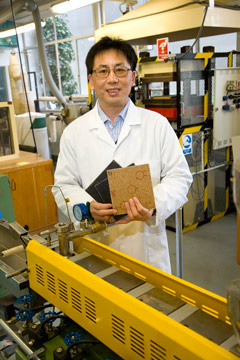World first in recycled building material
A University of Canterbury (UC) academic has produced a world first recycled plastic and sawdust composite building material.
Professor Shusheng Pang, Director of UC’s Wood Technology Research Centre, has discovered a practical use for some of the 160,000 tonnes of unwanted plastic that goes into New Zealand dumps each year. The product would be suitable for decking, joinery and panelling in a house or outdoor playgrounds as a substitute for chemically treated wood.

“New Zealand uses at least 200,000 tonnes of plastics a year and only 35,440 tonnes are recovered, with the rest ending up in landfills. Wood in its original form swells when it gets wet and shrinks when it is dried,” Professor Pang said.
“If not properly designed and constructed, wood stability and durability can be a concern for wooden structures such as leaky houses. Currently, wood is chemically treated for building purposes if high durability is required.
“I have developed a build material combining recycled plastics and wood. This material, wood-plastic composite, is more stable and durable than original wood and stronger than original plastics. The wood-plastic composite is processed through mixing and hot pressing in moulds. The final form of the product is either in a flat sheet or in complex moulded forms.”
Professor Pang, who will deliver a free public lecture on the breakthrough at UC on 29 August as part of the university’s What if Wednesdays lecture series, is in discussion with potential partners to build a plant for production of the wood-plastic products, probably based in Christchurch.
Plastics such as supermarket bags, milk bottles and other food containers, as well as the sawdust of radiata pine, will end up as a strong recycled building material. Although a wood-plastic product has been applied in North America and Europe before, it is a new concept to use recycled plastic for building materials.
“As well as producing a better building product, it also helps the environment using recycled plastic, which will reduce the landfills. The wood-plastic composite remains stable when exposed to water and durable in intense UV exposure and freezing-thaw conditions. It would make a great building material,” Professor Pang said.
Living in chemical-free homes partly made from sawdust and recycled plastic is now a giant step closer, but it has taken Professor Pang and his research team five years to reach this stage.
“We want to bring our product to market so Kiwis can use alternative materials to build their homes,” he said. “At the same time, we’ve discovered a practical use for the plastic clogging up our landfills. It’s very much a win-win solution.”
New partnership to focus on textile recycling
Textile Recyclers Australia has joined forces with the ARC Research Hub for Microrecycling of...
TerraCycle marks a decade of recycling in ANZ
During its time in the region, the Australian and New Zealand TerraCycle network has grown from...
UNSW innovation extends the life of plastic waste
The new method, which also removes dyes from the original plastic waste, has attracted the...











